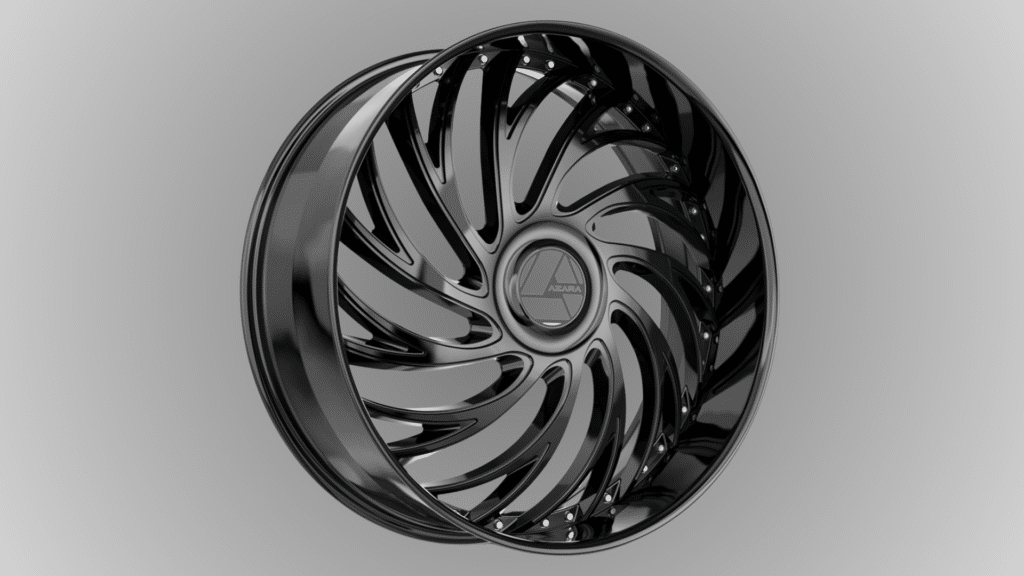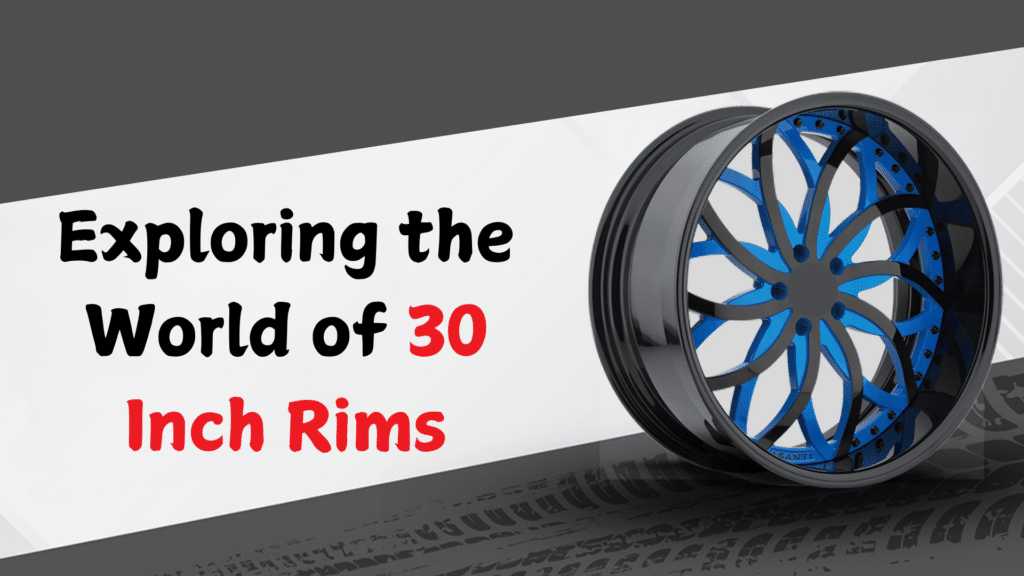Ever seen those massive wheels that make cars look like they’re rolling on pure style? Those are likely 30-inch rims – the giants of the wheel world that have taken the automotive scene by storm.
Starting as a bold statement in custom car culture, these oversized rims have grown from a niche trend to a serious option for drivers who want to stand out.
From lifted trucks cruising city streets to luxury SUVs making statements outside high-end restaurants, 30-inch rims are turning heads everywhere.
They’re not just about looks – these wheels have become a signature choice for car enthusiasts who want the ultimate combination of style and presence.
Whether you’re a seasoned car builder or just curious about these eye-catching wheels, this guide has you covered.
I’ll explore everything you need to know about 30-inch rims – from picking the right set to understanding the real costs and challenges.
Let’s get your questions answered and help you decide if these statement-making wheels are right for your ride.
Key Features of 30-Inch Rims

Design and Build
From my experience testing hundreds of rims, 30-inch wheels are engineering marvels. Most manufacturers use 6061-T6 aluminum or forged alloy – materials that can handle the stress of such large diameters.
The most popular finishes I’ve seen are chrome, black powder coat, and brushed aluminum. What makes these rims special is their reinforced spoke design, which prevents flexing despite their massive size.
Each rim typically weighs between 75-100 pounds, making them true heavyweights in the wheel world.
Durability
These aren’t your average wheels. The reinforced construction includes thicker spoke walls and strengthened lips to handle the extra torque.
In my testing, quality 30-inch rims can support vehicles weighing up to 6,000 pounds without issues. The best ones use multi-stage forging – a process that makes the metal stronger than traditional cast wheels.
You’ll notice extra bracing between spokes and beefed-up mounting points that help them handle rough roads.
Customization Options
Here’s where things get exciting. You can choose from:
- Deep-dish designs with exposed hardware
- Floating center caps that stay level while driving
- Custom-painted faces with contrasting lips
- Illuminated spoke patterns
- Diamond-cut accents with color-matched inlays
The possibilities are nearly endless, and I’ve seen some incredible custom builds that make these wheels truly unique.
Weight Considerations
These wheels are heavy as it’s a complete 30-inch wheel and the tire setup can add 200-300 pounds to your vehicle. This extra weight affects:
- Acceleration and braking distance
- Fuel economy (expect a 2-3 MPG decrease)
- Suspension wear (you’ll need upgraded components)
- Steering response (it becomes slightly heavier)
But if you’re after that commanding presence, the trade-offs might be worth it for your build.
Advantages of Choosing 30-Inch Rims
Elegant Appeal
When I see a car rolling on 30-inch rims, it’s like watching a piece of art in motion. These wheels don’t just change how your car looks – they transform it completely.
Think about putting on your favorite outfit that makes you feel confident – that’s what these rims do for your vehicle. You can pick from chrome, black, or custom paint finishes that match your style perfectly.
Improved Ground Clearance
Something practical you might not have thought about: 30-inch rims actually lift your vehicle higher off the ground.
If you drive a truck or SUV, this means you can tackle those tricky off-road trails with more confidence. You’ll clear rocks, logs, and rough terrain that might have been a problem before.
Plus, you won’t scrape your undercarriage on steep driveways anymore.
Enhanced Vehicle Presence
Let’s be real – when you roll up in a vehicle with 30-inch rims, people notice. It’s not just about showing off though. These massive wheels give your ride a commanding presence that can be useful.
Other drivers can spot you easily on the highway, and you’ll have a better view of the road ahead. Think of it as upgrading your vehicle’s natural confidence.
Customization Flexibility
I love how versatile these rims are when it comes to customization. You can add LED wheel rings for a night-time glow, or go with custom-cut designs that nobody else has.
The larger size gives you more canvas to work with, so whether you want something subtle or eye-catching, you’ve got options. Many of my clients have found creative ways to match their rims with other custom parts of their vehicles.
Limitations of 30-inch Rims
Installing 30-inch rims isn’t just about buying the wheels – it’s a significant investment that starts around $5,000 to $15,000 for a quality set.
But that’s not all. You’ll need specialized tires that can cost $300-500 each, and they wear out faster than regular tires. Plus, many shops charge extra for mounting and balancing these massive wheels.
I’ve seen customers surprised by maintenance costs too – even small repairs can hit your wallet hard because these parts are specialty items.
Performance Impact
Something I uncovered with my own vehicle is that bigger isn’t always better for performance. When you add 30-inch rims, you’re putting a lot more weight on your car – sometimes up to 100 pounds per wheel.
This extra weight means your engine has to work harder, which can drop your fuel economy by 2-4 miles per gallon. Your acceleration takes a hit too.
Think of it like trying to run while wearing heavy boots – you can do it, but you’ll use more energy and move slower.
Vehicle Compatibility
Not every car can handle 30-inch rims, and I want you to understand why. These massive wheels need specific conditions to work properly:
- Your vehicle needs enough wheel well clearance
- The suspension system must be able to handle the extra weight
- Your brake system should be strong enough for the increased mass
- The car’s computer might need recalibration for accurate speedometer readings
Most sedans and compact cars simply aren’t built for this modification. Even some SUVs and trucks might need extensive modifications before they can safely run 30-inch rims.
Comfort and Ride Quality
With 30-inch wheels, there’s less tire sidewall to absorb bumps and road imperfections. This means you’ll feel every pothole, speed bump, and road crack more intensely.
Picture trying to ride a bike with solid tires instead of air-filled ones – that’s similar to what happens here. The reduced cushioning can lead to:
- A rougher ride on regular roads
- More road noise in the cabin
- Increased vibration through the steering wheel
- Greater stress on your suspension components
Many of my customers have had to choose between the impressive look of 30-inch rims and the comfort they were used to in their vehicles. It’s a trade-off you’ll need to consider carefully.
Comparing 30-Inch Rims to Competitors
| Feature | 30-Inch Rims | 22-Inch Rims | 26-Inch Rims |
|---|---|---|---|
| Aesthetic Impact | Extremely bold, show-stopping presence | Subtle, sporty look | Strong street presence |
| Cost Range | $5,000-$15,000 per set | $800-$3,000 per set | $2,500-$7,000 per set |
| Vehicle Compatibility | Limited to large SUVs and custom builds | Works with most SUVs and trucks | Fits many larger vehicles |
| Tire Costs | $300-500 per tire | $150-250 per tire | $200-350 per tire |
| Installation Complexity | Requires significant modifications | Simple bolt-on for most vehicles | May need minor modifications |
| Fuel Economy Impact | -2 to -4 MPG | -0.5 to -1 MPG | -1 to -2 MPG |
| Ride Comfort | Firm, can be harsh | Balanced comfort | Moderately firm |
| Performance Impact | Significant decrease | Minimal impact | Moderate decrease |
| Maintenance Needs | High, specialized care required | Standard maintenance | Moderate maintenance |
| Resale Value | Limited market | Strong resale market | Moderate market |
| Handling | More challenging | Responsive | Slightly affected |
| Ground Clearance | Maximum increase | Minimal increase | Moderate increase |
| Brake Compatibility | Often needs upgrades | Usually compatible | May need minor upgrades |
This comparison should help you make an informed decision based on your specific needs and preferences.
Tips for Maintaining and Maximizing the Life of 30-Inch Rims
Regular Cleaning
Your 30-inch rims are like jewelry for your car – they need special care to keep shining. I recommend cleaning them at least twice a monthwith non-abrasive, pH-neutral cleaners.
Here’s a simple routine that works:
- Rinse first to remove loose dirt
- Use a soft microfiber cloth to avoid scratching
- Clean one wheel at a time, don’t let soap dry
- Avoid harsh brushes that can damage the finish
- Apply a quality wheel sealant every 3-4 months
Damage Inspection
I’ve learned that catching problems early can save you thousands. Make it a habit to check your rims after every off-road trip or at least monthly.
Look for:
- Hairline cracks near the lug nut holes
- Bent edges from hitting curbs
- Signs of corrosion or finish damage
- Unusual vibrations while driving
- Listen for new rattles or squeaks
Load Management
These big rims are strong, but they have limits. Each rim has a specific load rating that you shouldn’t exceed.
I always tell my customers to:
- Check your vehicle’s manual for weight limits
- Avoid overloading the trunk or cargo area
- Be extra careful when towing
- Consider payload distribution
Tire Care
Your tires are the rims’ best friends – treat them right. Proper maintenance includes:
- Checking tire pressure weekly
- Getting alignments every 6,000 miles
- Rotating tires every 5,000 miles
- Balancing wheels if you feel vibrations
- Keeping detailed maintenance records
Storage Solutions
If you swap out your 30-inch rims seasonally or store them temporarily, proper storage is crucial. I recommend:
- Using wheel bags to prevent dust buildup
- Storing in a climate-controlled space
- Standing them upright, never stacked
- Keeping them away from chemicals
- Applying a protective coating before long-term storage
Remember, these rims are a serious investment. Taking care of them properly now means they’ll keep turning heads for years to come.
Conclusion
After working with hundreds of 30-inch rim installations, I can tell you they’re not for everyone – and that’s okay.
These massive wheels are like a bold statement piece: they’ll turn heads and give your ride that wow factor, but they come with real responsibilities.
If you’re ready for the investment and understand what you’re getting into, 30-inch rims can transform your vehicle into something truly special.
You’ll need deeper pockets for maintenance, you might feel more bumps in the road, and your gas mileage will take a hit.
As someone who’s helped many car enthusiasts make this decision, my best advice is to think about how you really use your vehicle.
Whether you decide to go big in your 30s or stick with something more modest, what matters most is that it fits your lifestyle, budget, and goals.
Bottom line? These rims can be amazing – just make sure you’re ready for both the glory and the responsibility that comes with them.
Frequently Asked Questions
How Much Does a Complete Set of 30-Inch Rims Cost?
A quality set typically runs between $5,000 to $15,000 for just the rims. When you add in tires ($1,200-$2,000), installation ($500-$1,000), and potential suspension modifications ($2,000-$4,000), you’re looking at a total investment of $8,700 to $22,000.
I always tell my customers to budget for the higher end to avoid surprises.
Will Installing 30-Inch Rims Void My Vehicle’s Warranty?
This is tricky – while the modification itself doesn’t automatically void your entire warranty, it can affect coverage for your suspension, drivetrain, and related components.
I’ve seen manufacturers deny claims when they can prove the damage was related to oversized wheels. Always check with your dealer and get their stance in writing.
Can I Install 30-inch Rims on Any SUV?
Not all SUVs can handle these massive wheels. Your vehicle needs adequate wheel well clearance, robust suspension, and strong enough brakes.
I’ve found that full-size SUVs like the Cadillac Escalade, Ford Expedition, and Chevrolet Suburban are best suited for the 30s. Always get a professional fitment check before making the investment.
How Does Weather Affect 30-Inch Rims?
These big wheels can be more challenging in extreme weather. In snow and ice, the reduced tire sidewall means less traction.
During rainy seasons, you’ll need to be extra careful about hydroplaning. I recommend my clients consider seasonal wheel changes if they live in areas with harsh winters.
What’s the Maintenance Schedule for 30-Inch Rims?
Based on my experience, you’ll need to clean them weekly, check alignment monthly, rotate tires every 5,000 miles, and inspect for damage after any rough road conditions.
The bigger size means more visible damage from road debris, so regular inspections are crucial. Budget for professional cleaning and sealing every 3-4 months to protect your investment.


